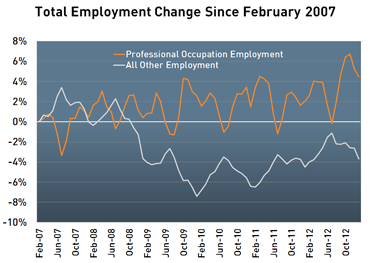 This year, however, is already presenting new challenges and changing
dynamics. The debt crisis in Europe has backed off from the cliff, putting a pin
back in one of the largest potential economic grenades on the horizon. Yet, the
cost-cutting effects from sequestration appear increasingly unavoidable and will
in the coming months have measurable consequences across the military, military
support, research, education and other sectors that rely heavily on government
support.
This year, however, is already presenting new challenges and changing
dynamics. The debt crisis in Europe has backed off from the cliff, putting a pin
back in one of the largest potential economic grenades on the horizon. Yet, the
cost-cutting effects from sequestration appear increasingly unavoidable and will
in the coming months have measurable consequences across the military, military
support, research, education and other sectors that rely heavily on government
support.While the cuts will have a rapid near-term effect on employment, they may also create a temporary talent acquisition opportunity for employers. Many of the positions affected are filled by highly trained people in disciplines that have continued to experience increasing talent shortages in recent years.
"In layoffs like these, that have nothing to do with job performance but rather fallout from much larger issues, highly qualified and capable people end up entering the job market," says Rob Romaine, president of MRINetwork. "It means a short window of availability for private sector employers to scoop up experienced professionals in disciplines like engineering, IT, accounting, and project management."
Total employment in the U.S. shrank by more than 6 percent during 2008 and 2009. Yet, despite comprising more than 20 percent of the U.S. workforce, employment of those in professional and related occupations remained essentially flat during those years and has since resumed its pace of growth.
“Historically, government layoffs in sectors like defense have had only a short-term impact on employment because the types of people who are laid off are inherently highly employable,” notes Romaine. “While these cuts will be reaching far beyond defense spending, the principle still applies for many of the industries that will be affected, which points to an opportunity for employers.”
This isn’t to say that sequestration will be a big boon for the U.S. economy. Many economists project sequestration will remove as much as 1.5 percent of GDP from the economy in 2013 and blame it for the sharp decline in GDP growth during the 4th quarter of 2012. Private-sector activity, however, is rebounding, and in the 4th quarter was enough to counter nearly a 15-percent drop in government expenditure and keep total GDP growth virtually flat.
“There was such a shortage of experienced talent before the recession that even with the sharpest economic decline in more than a generation, professional employment levels didn’t decline,” notes Romaine. “While the economy may slow again by the end of the year, we shouldn’t expect that to lower the demand for professional talent nor affect the availability of experienced professionals.”
